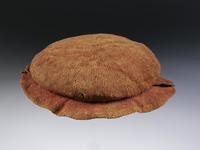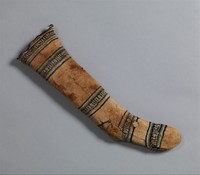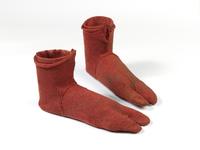Items
Tag
socks
-
 Cap This reddish-brown closely knitted cap with flat crown, has lost original felt surface and presumably bright red color. The cap has a slightly projecting brim of reverse stocking stitch construction. there are the remains of strings attached at each side suggesting that the cap was meant to be tied at the crown. Size suggests it may have belonged to young boy/small adult male however its was popular during the time for men to wear these caps on the side of the head, rather than on top. The manufacture of caps during this time was mandated from 1488 on control by Act of Parliament. In 1571, the “Cappers Act” stated that every person above the age of six years (excluding women and noblemen) shall wear a “on Sundays and Holidays a cap of wool, thickens and dressed in England” in order to keep the domestic production alive. This attributes the owner as securely in the middle class.
Cap This reddish-brown closely knitted cap with flat crown, has lost original felt surface and presumably bright red color. The cap has a slightly projecting brim of reverse stocking stitch construction. there are the remains of strings attached at each side suggesting that the cap was meant to be tied at the crown. Size suggests it may have belonged to young boy/small adult male however its was popular during the time for men to wear these caps on the side of the head, rather than on top. The manufacture of caps during this time was mandated from 1488 on control by Act of Parliament. In 1571, the “Cappers Act” stated that every person above the age of six years (excluding women and noblemen) shall wear a “on Sundays and Holidays a cap of wool, thickens and dressed in England” in order to keep the domestic production alive. This attributes the owner as securely in the middle class. -
 Sock Earliest example of double-needle knitting. Made in North Africa during Islamic rule as assumed from the indigo and white designs that echo color combinations found in most islamic ceramics of the time. The sock was most likely worked from toe to top with difference in needle size accounting for the change in gauge.
Sock Earliest example of double-needle knitting. Made in North Africa during Islamic rule as assumed from the indigo and white designs that echo color combinations found in most islamic ceramics of the time. The sock was most likely worked from toe to top with difference in needle size accounting for the change in gauge. -
 Pair of socks The Romano-Egyptian socks were excavated from ancient Oxyrhynchus, a Greek colony on the Nile in central Egypt at the end of the 19th century. They use a technique called nålbinding which predates modern knitting. The socks were made with red wool and each sock has a divided big toe so as to be worn with sandals. The construction of these socks, which have a turned heel, began at the toe and finished at the ankle with added stitches in the front to form an under-flap, ending in a loop, for fastening or tying.
Pair of socks The Romano-Egyptian socks were excavated from ancient Oxyrhynchus, a Greek colony on the Nile in central Egypt at the end of the 19th century. They use a technique called nålbinding which predates modern knitting. The socks were made with red wool and each sock has a divided big toe so as to be worn with sandals. The construction of these socks, which have a turned heel, began at the toe and finished at the ankle with added stitches in the front to form an under-flap, ending in a loop, for fastening or tying.